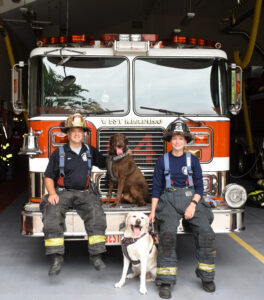In light of Pet Fire Safety Day, which takes place on July 15th this year, we took time to chat with Andy Gudinas – Berks County Suppression Instructor, Lieutenant and Paramedic, Samantha Kaag – Berks County EMT and Firefighter, and Chad Moyer – West Reading Fire Chief, about the different ways we can ensure the safety of our pets before and during a fire!
What are some common ways pets can start a fire?
Andy Gudinas (A.G.): Most common are kitchen fires, whether by bumping the knobs for the burners or knocking something onto the stove.
Samantha Kaag & Chad Moyer (S.K./C.M.): Stoves are the number one cause of fires by pets. Electrical cords are also a hazard because dogs, cats, mice, bunnies will sometimes chew on them. Unattended lit candles are not only dangerous on their own but can be easily knocked over by pets.
hazard because dogs, cats, mice, bunnies will sometimes chew on them. Unattended lit candles are not only dangerous on their own but can be easily knocked over by pets.
How can I prevent my pet from starting a fire?
A.G.: Prevention is not so easy when animals have free reign. Keeping them out of the kitchen unattended is best practice.
S.K./C.M.: You can remove stove knobs or use stove knob covers, block off access to the kitchen, and never leave an active stovetop or a lit candle unattended. Also, DO NOT leave food boxes, bags, or anything your pet may want to jump up to get in, on top of the stove. Keep pet-designated food/water bowls away from risky areas. Hide your plugged-in electrical cords appropriately and check on your pets (especially smaller ones), periodically, when left to roam.
What should I do with my pets during a fire?
A.G.: You would be surprised; the pets usually have a natural instinct to flee when there is a fire. A lot of the time the pets beat the humans out of the house.
S.K./C.M.: Try to evacuate the house with them; this can be made easier by keeping leashes and crates near an exit and having an escape plan in which someone is designated to grab the animal, if able to do so safely. If you cannot secure them get out and stay out.
What if I can’t take my pet with me when I escape from the fire?
 A.G.: If you can’t get them out, DO NOT go back in to get them. Let the arriving responders know the last known location and a description of the animal.
A.G.: If you can’t get them out, DO NOT go back in to get them. Let the arriving responders know the last known location and a description of the animal.
S.K./C.M.: You should get yourself to safety and let the dispatcher and/or firefighters know that there are pets inside, upon arrival, and tell them about any potential hiding spots your pets may run to. When you get out, stay out, leave it to the firefighters on the scene.
How can I prepare myself, my family and my pet for a fire (in general)?
A.G.: Practice fire drills and establish escape routes. Designate a meeting place. If you do this often, it becomes muscle memory for your pet. Positive reinforcement is key. Lastly, post pet finders on or near the front door — they let responders know to keep pets in mind while performing primary and secondary searches.
S.K./C.M.: You can prepare by having a fire plan in place for your family that includes your pets; having a plan for a fire is important for any family to practice. There are also stickers you can put on your doors and windows to alert firefighters that there are pets inside.
In one year, there are nearly 360,000 house fires; pets cause over 1,000 of them. Unfortunately, almost 40,000 pets do not survive because of fires each year.* Awareness and having a fire plan can save the lives of not only you but your loved ones and your pets as well.

